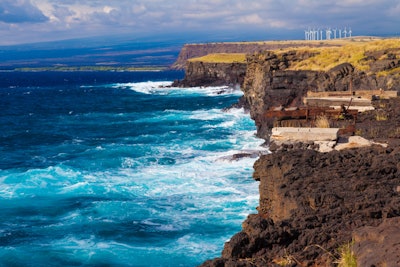
What’s been called the most aggressive clean energy goal in the nation, legislation was enacted last year with the goal that the state of Hawaii will use 100 percent renewable sources by 2045.
Connie Lau, president and CEO of Hawaiian Electric Industries Inc., and GE Ecomagination Advisory Board member, explains why the state’s largest electricity supplier supports the goal and what they are learning as they work to get there.
1. What are the biggest success factors for other utilities and energy players really going big on renewables?
There is a misconception that utilities do not welcome renewable energy. I think that couldn’t be further from the truth. If you look at the statistics for the industry in total, the utilities are some of the companies that are adopting and integrating renewable energy at a record clip. The most successful are those who have taken advantage of the resources they have in their locale, similar to folks in the Midwest or in Texas where there are great wind sources.
One thing that we cannot lose sight of is that energy is still an expense to customers, and what’s really important to understand is that cost continues to be a factor to consumers. The successful utility is the one that can marry both the delivery of value to customers at a price that they’re willing to pay. There is much focus these days about customer choice and new products and services. It’s important that as we move down that route that we design products that consumers value, and are willing to pay for.
2. You are a key player in implementing Hawaii’s ambitious renewable energy goals. What are the most important reasons for Hawaii’s transition to renewables?
We now have 17 percent of customers with rooftop systems. Among customers who have single-family homes with rooftops that can actually have systems placed on them, we’re at about 30 percent, so about 80,000 systems approved or installed, which is quite a lot for a small place like Hawaii.
 (Image credit: Getty Images via GE Reports)
(Image credit: Getty Images via GE Reports)For Hawaii, it’s not only an environmental mandate — it’s an economic mandate. We are the nation’s most oil-dependent state, and our resources pay for imported fuel. Finding a way to use our indigenous renewable resources in-state —with plenty of sun and wind — is a much better economic proposition for Hawaii.
Our largest industry is tourism. People come to Hawaii because it’s a very special place to live. If we want to preserve Hawaii’s pristine environment, we have to pay attention to climate change and rising sea levels.
3. How are you working to shift behavior in how people use energy?
In Hawaii we are looking to help customers have choices, but also help shift customer demand to times of the day when we have the most plentiful renewable energy that doesn’t require import of fossil fuels into the islands to satisfy demand. Last month, the Hawaii Public Utilities Commission issued new rate structures that divide the day into three segments: mid-day (9 a.m. to 5 p.m.), on-peak (5 p.m. to 10 p.m.) and off-peak (10 p.m. to 9 a.m.).
During the daytime when the sun is out and we have lots of solar energy on the system, that rate is the lowest to encourage usage. Then you hit our peak hours when everyone comes home and starts cooking, turning lights on, doing laundry and watching TV — when the rate will be the highest.
4. So now you have a lot more solar in play. How are you adapting?
In the last year our public utilities commission has taken some important steps to adapt to the dramatic growth of rooftop solar. Hawaii is transitioning away from a retail net energy metering structure where consumers received tax credits in addition to retail rates for the energy they sold into the grid. With so much solar now being installed on homes, the program was starting to create issues with costs being shifted from one customer segment to another.
The commission came out with what I think is really an industry and regulatory leading decision that closed the net energy metering program but opened up new solutions for customers. One program transitions pricing for energy being sold into the grid to be more market based pricing. Another program provides a nominal-export option for homeowners who want to install solar on their home but live in an area where the local grid network can’t support more energy being sold into the grid to include storage and use the solar energy for their own use.
Connie Lau is Hawaiian Electric Industries’ president and chief executive officer and chairman of the board of Hawaiian Electric.






















